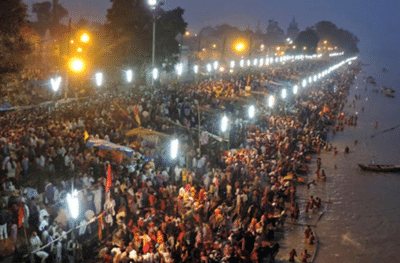Ayodhya, the birthplace of Lord Rama, is renowned worldwide as a religious city. Situated on the sacred banks of the Saryu River, this city attracts devotees year-round, but its grandeur is further enhanced during the month of Kartik. During this time, millions of devotees visit Ayodhya and earn merit by performing the 14 Kosi and Panchkosi Parikramas. Approximately 3 million devotees are expected to participate in the 14 Kosi, 5 Kosi Parikramas, and the Kartik Purnima Snan, scheduled from October 30th. Let's explore the significance and rules of the 14 Kosi and 5 Kosi Parikramas.

According to religious belief, the Panchkosi Parikrama begins on Devuthani Ekadashi in the month of Kartik. This year, the Parikrama will begin at 4:02 am on November 1st and conclude at 2:57 am on November 2nd. The 14 Kosi Parikrama will begin at 4:45 am on October 30th and continue until 4:41 am on October 31st. Mahant Shashikant Das of the Char Dham Temple in Ram Kachari explains that performing the 14 Kosi Parikrama purifies one spiritually and liberates one from sins. Performing the Panchkosi Parikrama also brings auspicious results and merits equivalent to performing yagnas for many lifetimes.
Parikrama Route and Distance
The 14 Kosi Parikrama encircles the city of Ayodhya for approximately 42-45 kilometers, while the Panchkosi Parikrama covers a distance of 10-15 kilometers within the Ayodhya Dham area. Devotees perform these parikramas immersed in devotion to the Lord. Religious belief holds that this parikrama purifies the five elements of the body and erases the sins of many lifetimes.

5 Rules for Performing the Parikrama
Before beginning the Parikrama, devotees must bathe in the Saryu River.
After this, they begin the Parikrama from a designated spot, chanting Jai Shri Ram.
It is essential to maintain devotion and remembrance of the Lord throughout the Parikrama.
During this time, sattvik food such as fruits, nuts, and sweets is consumed.
After completing the circumambulation, devotees return and chant Jai Shri Ram and visit major monasteries and temples.
PC Social Media
You may also like

Every driver in the UK at risk of £1,000 fine this week

Union Minister Manohar Lal Khattar extends greetings on Chhath Puja

Govt never 'pressurised' us to invest in any particular company: Ex top LIC officials

University of Queensland and IIT Delhi open applications for joint PhD programme commencing July 2026

SIR backdoor entry for NRC, BJP interfering in ECI, says Bengal Minister







